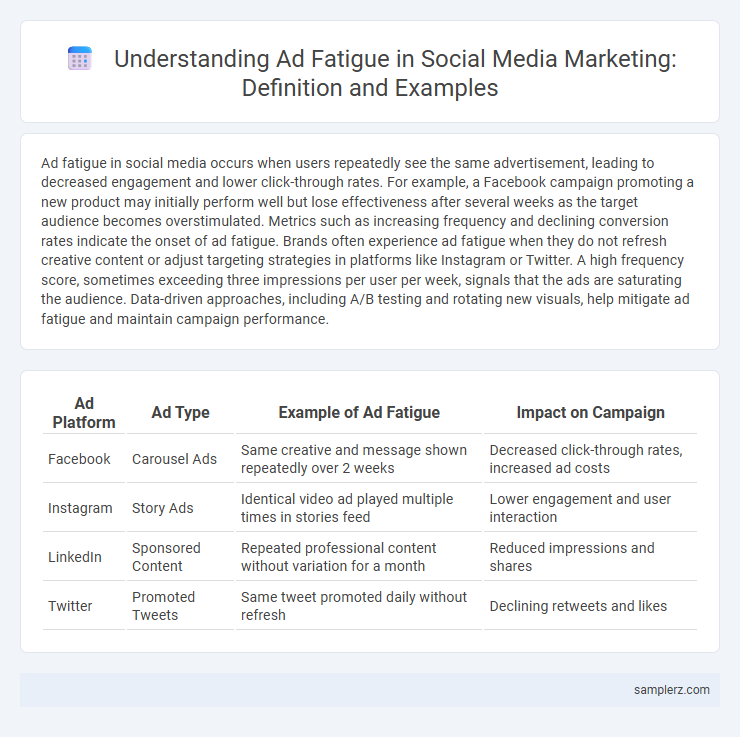Ad fatigue in social media occurs when users repeatedly see the same advertisement, leading to decreased engagement and lower click-through rates. For example, a Facebook campaign promoting a new product may initially perform well but lose effectiveness after several weeks as the target audience becomes overstimulated. Metrics such as increasing frequency and declining conversion rates indicate the onset of ad fatigue. Brands often experience ad fatigue when they do not refresh creative content or adjust targeting strategies in platforms like Instagram or Twitter. A high frequency score, sometimes exceeding three impressions per user per week, signals that the ads are saturating the audience. Data-driven approaches, including A/B testing and rotating new visuals, help mitigate ad fatigue and maintain campaign performance.
Table of Comparison
| Ad Platform | Ad Type | Example of Ad Fatigue | Impact on Campaign |
|---|---|---|---|
| Carousel Ads | Same creative and message shown repeatedly over 2 weeks | Decreased click-through rates, increased ad costs | |
| Story Ads | Identical video ad played multiple times in stories feed | Lower engagement and user interaction | |
| Sponsored Content | Repeated professional content without variation for a month | Reduced impressions and shares | |
| Promoted Tweets | Same tweet promoted daily without refresh | Declining retweets and likes |
What Is Ad Fatigue on Social Media?
Ad fatigue on social media occurs when audiences become overly exposed to the same advertisement, leading to decreased engagement rates and higher ad costs. Marketers experience diminishing returns as click-through rates (CTR) drop and frequency metrics exceed optimal thresholds, often above 3-4 impressions per user. Identifying ad fatigue through performance analytics enables timely refreshment of creatives and messaging to maintain audience interest and campaign effectiveness.
Visual Signs of Ad Fatigue in Campaigns
Visual signs of ad fatigue in social media campaigns include a noticeable decline in click-through rates, decreased engagement metrics such as likes, comments, and shares, alongside repetitive ad creatives showing high frequency without variation. Advertisers often observe increased negative feedback and muted audience responses as users become desensitized to the same image or video content. Monitoring these visual cues helps marketers identify when it's time to refresh creative assets to maintain campaign effectiveness and audience interest.
Click-Through Rate Decline: A Key Indicator
A sharp decline in click-through rates (CTR) signals ad fatigue on social media platforms like Facebook and Instagram, where repeated exposure to the same ad reduces audience engagement. When CTR drops below industry benchmarks, it indicates that the target audience has become desensitized, necessitating creative refresh or audience retargeting. Monitoring CTR trends closely helps marketers identify fatigue early and optimize campaign performance effectively.
Repetitive Messaging and User Disengagement
Repetitive messaging in social media ads leads to ad fatigue, causing users to ignore or actively avoid branded content. Studies show that exposure to the same ad multiple times decreases click-through rates by up to 35%, highlighting the risk of user disengagement. Marketers must continuously refresh creative content to maintain audience interest and maximize campaign performance.
Case Study: Facebook Ad Fatigue
Facebook ad fatigue occurs when users repeatedly see the same ad, leading to decreased engagement and higher cost per click (CPC). A case study revealed that after two weeks of displaying the same creative, click-through rates (CTR) dropped by 30%, while CPC increased by 25%, signaling reduced ad effectiveness. Rotating creatives and targeting new audience segments helped reverse performance declines and maintain campaign ROI.
Instagram Story Ads: A Fatigue Example
Instagram Story Ads often experience ad fatigue when the same creative is shown repeatedly to the same audience, leading to declining engagement rates and increased ad costs. Marketers observing a drop in swipe-up actions or rising frequency metrics should refresh visuals and messaging to maintain user interest. Effective strategies include rotating ad creatives and adjusting targeting parameters to combat audience saturation and preserve ad performance.
The Impact on Brand Perception
Repeated exposure to the same ad on social media platforms can lead to ad fatigue, causing users to develop negative associations with the brand. This decreased engagement often results in reduced click-through rates and diminished conversion rates, directly impacting overall campaign ROI. Brands experiencing ad fatigue risk eroding customer trust and weakening brand loyalty, ultimately harming long-term perception and market positioning.
User Feedback Highlighting Saturation
User feedback often reveals ad fatigue through comments expressing annoyance or repetitiveness on social media platforms such as Facebook and Instagram. Negative sentiment and increased ad blocking rates serve as clear indicators of user saturation and diminishing ad effectiveness. Brands must monitor engagement metrics and direct user responses to adjust campaign frequency and creative content effectively.
Decreasing ROI from Overexposure
Repeatedly displaying the same social media ad to the target audience leads to ad fatigue, causing users to ignore or actively avoid the content. This overexposure significantly decreases click-through rates and conversion rates, resulting in a sharp decline in return on investment (ROI). Marketers must monitor frequency metrics closely to optimize ad delivery and maintain campaign effectiveness.
Solutions to Combat Social Media Ad Fatigue
Rotating ad creatives and refreshing visual elements regularly can significantly reduce social media ad fatigue by keeping content engaging and preventing audience burnout. Implementing frequency caps ensures users are not overexposed to the same advertisement, maintaining a positive brand perception. Utilizing audience segmentation allows for personalized ads that resonate with specific user interests, enhancing relevance and interaction rates.

example of ad fatigue in social media Infographic
 samplerz.com
samplerz.com